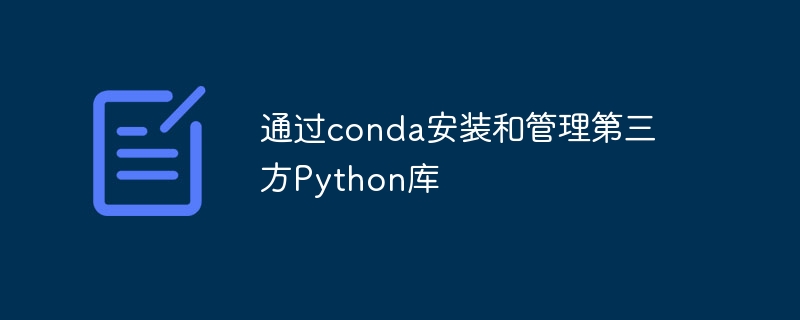

Install and manage third-party Python libraries through conda
Python is a powerful programming language that is widely used in data analysis, machine learning, artificial intelligence and other fields . In Python programming, we often need to use various third-party libraries to extend Python's functions. Installing and managing third-party libraries through conda can simplify our workflow and improve efficiency. This article will introduce how to use conda to install and manage third-party Python libraries, and provide specific code examples.
1. What is conda?
conda is an open source software package management system and environment management system. It can manage software packages for various programming languages, such as Python, R, Julia, etc. conda can be used to install, uninstall, update and manage various software packages, and can create and manage different virtual environments to meet different project needs.
2. Install conda
First, we need to install conda. conda can be downloaded from the official website https://www.anaconda.com. Choose the correct version according to your operating system and follow the installation wizard to install it.
3. Use conda to install third-party libraries
The first step to install third-party libraries is to open a terminal or command prompt window and activate the conda environment. In Windows systems, you can open the terminal through the Anaconda Prompt in the start menu. On a Mac or Linux system, it can be opened through the terminal or command prompt.
3.1 Search for libraries that need to be installed
First, we can use conda’s search function to find libraries that need to be installed. Search the library through the following command:
conda search library name
For example, if we want to install the pandas library, we can use the following command to search:
conda search pandas
3.2 Installing the library
After finding the library that needs to be installed, we can use the following command to install the library:
conda install library name
For example, to install pandas Library, you can use the following command:
conda install pandas
3.3 Update library
If we have already installed a library but want to update to the latest version, we can use The following command is used to update the library:
conda update library name
For example, to update the pandas library, you can use the following command:
conda update pandas
3.4 Uninstall the library
If we want to uninstall a library, we can use the following command to uninstall the library:
conda remove library name
For example, to uninstall the pandas library, you can use The following command:
conda remove pandas
4. Create and manage virtual environments
In addition to installing and managing third-party libraries, conda can also create and manage virtual environments. A virtual environment allows us to use different versions of software packages on the same machine at the same time to meet the needs of different projects.
4.1 Create a virtual environment
We can use the following command to create a virtual environment:
conda create --name environment name
For example, to create a For a virtual environment named test_env, you can use the following command:
conda create --name test_env
4.2 Activate and exit the virtual environment
After creating the virtual environment, we can use The following command activates the virtual environment:
conda activate environment name
For example, to activate a virtual environment named test_env, you can use the following command:
conda activate test_env
If you want to exit the virtual environment, you can use the following command:
conda deactivate
4.3 Manage the virtual environment
We can use the following command to view the created Virtual environment:
conda env list
We can use the following command to delete the created virtual environment:
conda env remove --name environment name
For example, to delete the virtual environment named test_env, you can use the following command:
conda env remove --name test_env
Summary:
This article introduces how to use conda to install and manage third-party Python libraries, and how to create and manage virtual environments. Through conda, we can easily search, install, update and uninstall various libraries, and at the same time create and manage different virtual environments. Hopefully these code examples will be helpful in your work in Python programming.
The above is the detailed content of Use conda to install and operate Python libraries. For more information, please follow other related articles on the PHP Chinese website!
 How to install third-party libraries in sublime
How to install third-party libraries in sublime
 What is the difference between pass by value and pass by reference in java
What is the difference between pass by value and pass by reference in java
 How to make a round picture in ppt
How to make a round picture in ppt
 The Metaverse recognizes the top ten potential coins
The Metaverse recognizes the top ten potential coins
 How to solve the problem of missing steam_api.dll
How to solve the problem of missing steam_api.dll
 The role of cloneable interface
The role of cloneable interface
 Characteristics of the network
Characteristics of the network
 Is there a big difference between c language and Python?
Is there a big difference between c language and Python?
 The meaning of European and American website construction
The meaning of European and American website construction




